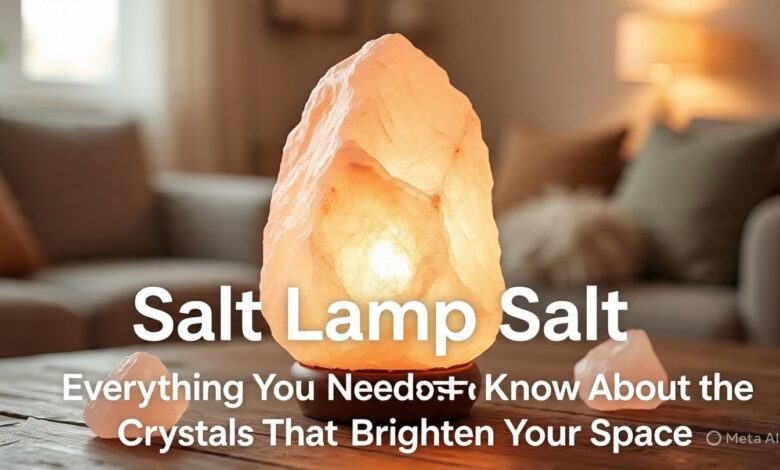Salt Lamp Salt: Everything You Need to Know About the Crystals That Brighten Your Space

When you think about salt lamps, what comes to mind? Maybe that cozy glow in a spa, or perhaps the promise of better air quality and wellness benefits that many claim these beautiful fixtures offer. But beneath the warm, amber hue lies something more intriguing—the salt itself, often simply called “salt lamp salt,” a mineral with a rich history, scientific complexity, and a host of misconceptions.
In this deep dive, I’ll unpack everything you need to know about salt lampsalt—what it is, its origins, health claims, and how to choose and care for your salt lamp. With over a decade of experience in natural wellness products and a passion for demystifying such popular yet often misunderstood items, I aim to provide insights grounded in both science and real-world application.
What Is Salt Lamp Salt? The Basics
The Composition of Salt Lamp Salt
Salt lampsalt is primarily composed of halite, a crystalline mineral form of sodium chloride (NaCl). Unlike table salt, which is heavily processed and often includes anti-caking agents, salt lampsalt is usually mined directly from natural salt deposits. Its mineral content can vary slightly depending on the location, but most salt lamps are made from rock salt that contains trace minerals such as magnesium, potassium, and calcium.
Natural vs. Refined Salt: What’s the Difference?
While both originate from the same source, the key difference lies in processing. Refined table salt is typically stripped of most minerals and bleached, then fortified with iodine or anti-caking agents. Salt lamp salt, on the other hand, is minimally processed, often leaving behind these trace minerals, which can give the salt a slightly different hue—ranging from pink and reddish to deep orange.
This mineral content is often touted as a health plus, but it’s worth noting that the actual quantities are minimal and unlikely to impact your diet significantly. Still, these minerals contribute to the unique aesthetic and subtle flavor differences, which many enthusiasts find appealing.
Salt Lamp Salt in Its Natural State
Most salt lampsalt is harvested from ancient seabeds or salt deposits formed millions of years ago. The most famous sources include the Himalayan Mountains, which produce the iconic pink salt, and deposits in Pakistan, Bolivia, and the U.S. Southwest. These deposits are mined, then cut into large chunks suitable for carving into lamps or smaller pieces for culinary use.
The Science and Myths of Salt Lamp Salt
Do Salt Lamps Actually Purify the Air?
One of the most common claims about salt lampsalt is that it purifies indoor air by attracting pollutants, dust, and allergens. The theory goes that the salt attracts moisture and pollutants through hygroscopic properties, trapping airborne particles. When the lamp heats up from the bulb, it supposedly releases cleaner, ionized air.
However, scientific evidence supporting this is limited. Most studies are anecdotal or based on small-scale observations. The amount of salt and surface area involved in a typical salt lamp isn’t enough to significantly impact air quality. If you’re dealing with serious air pollution or allergies, consider dedicated air purifiers rather than relying solely on a salt lamp.
Ionization and Electrostatic Claims
Some enthusiasts suggest that salt lamps generate negative ions, which can boost mood, reduce stress, and improve air quality. While certain natural sources like waterfalls and forests do produce negative ions, salt lamps are unlikely to do so in any meaningful way. The small electrical charge produced by the heat of the bulb isn’t enough to generate significant ionization.
The idea that salt lampsalt contributes to a healthier environment is appealing, but it should be viewed as a calming, aesthetic addition rather than a proven health device.
The Health Benefits You Might Actually Experience
While the scientific backing for many health claims is shaky, some users report subjective benefits such as:
- Improved sleep due to ambient lighting
- Reduced electromagnetic interference (though evidence is sparse)
- Enhanced mood from the cozy glow
These effects are more likely psychological, rooted in the calming ambiance rather than any direct chemical or physical change caused by the salt lampSalt
.
Choosing the Right Salt Lamp and Salt for Your Space
How to Identify Quality Salt Lamp Salt
When shopping for a salt lamp, especially if you want to maximize both aesthetic and potential benefits, focus on:
| Criteria | What to Look For |
|---|---|
| Origin | Himalayan, Pakistani, or other reputable sources |
| Color | Deep pink, reddish, or orange hues—indicating mineral richness |
| Purity | Minimal impurities or additives |
| Texture | Coarse, crystalline chunks that are resistant to crumbling |
| Certification | Authenticity certificates from trusted suppliers |
High-quality salt lampsalt will have a natural, unprocessed appearance, with no artificial dyes or additives.
Types of Salt Lamps and Salt Choices
Salt lamps come in various shapes—chunk, ball, pyramid, or carved figurines. The type of salt used can influence the appearance and energy of the lamp:
- Himalayan Pink Salt: The most popular, known for its distinctive color and mineral content.
- Baltic Sea Salt: Light-colored, with a milder hue.
- Rock Salt: Usually larger chunks, often used for decorative purposes.
Choosing the right salt depends on your aesthetic preference, the size of the space, and whether you prefer a more vibrant or subtle glow.
Practical Tips for Care and Maintenance
To keep your salt lamp in top condition:
- Use a damp cloth to wipe away dust—avoid water or cleaning agents.
- Keep the lamp on as much as possible to prevent moisture absorption.
- Place it in a dry, ventilated area.
- Consider using a hygrometer to monitor humidity levels—excess moisture can cause the salt to sweat or deteriorate.
- Use a dedicated bulb with appropriate wattage to prevent overheating or melting.
Remember, salt lamp salt is hygroscopic, meaning it attracts moisture from the air. Proper placement and maintenance will extend your lamp’s lifespan and preserve its beauty.
The Practical Perspective: Should You Use Salt Lamp Salt?
Benefits Beyond the Hype
While the health claims around salt lampsalt are often exaggerated, many users find genuine value in owning one. The soft glow provides a relaxing atmosphere, perfect for meditation, reading, or creating a cozy corner. The minimal mineral content, while not a game-changer nutritionally, does add a layer of authenticity and aesthetic appeal.
Furthermore, the process of selecting, caring for, and even occasionally replacing salt lampsalt can be a mindful activity that enhances your overall well-being.
Limitations and Realistic Expectations
It’s important to approach salt lamp salt with realistic expectations. Don’t rely on it as a primary air purifier or health remedy. Instead, see it as a natural, calming decorative element that complements a healthy lifestyle.
If you’re sensitive to humidity or live in a particularly damp climate, be prepared for some maintenance. Also, ensure your salt lamp is from a reputable source to avoid counterfeit or low-quality products that may not contain genuine salt or could pose safety risks.
Final Thoughts: The Bright Side of Salt Lamp Salt
Salt lampsalt is more than just a mineral; it’s a centuries-old natural resource that has found renewed popularity in the form of decorative, wellness-oriented lamps. While scientific evidence supporting extraordinary health claims remains limited, the aesthetic and atmospheric benefits are undeniable for many.
By understanding the origins, composition, and realistic benefits of salt lampsalt, you can make informed choices that enhance your space without falling prey to overstated promises. Whether you’re seeking a warm glow, a touch of natural beauty, or a subtle way to create a calming environment, salt lamps are a charming addition—grounded in natural mineral wonder.
Frequently Asked Questions
Q1: Is salt lamp salt edible?
A1: Technically, yes. The salt used in lamps is edible rock salt. However, it’s not processed for culinary use, so it may contain impurities or minerals that aren’t ideal for eating in large quantities.
Q2: Can I use salt lamp salt in cooking?
A2: While the salt is safe in small amounts, it’s best to use culinary-grade salt for cooking to ensure purity and safety.
Q3: Do salt lamps really help with allergies or respiratory issues?
A3: Scientific evidence is limited. While some find it beneficial psychologically, don’t rely on salt lamps as a primary treatment for respiratory problems.
Q4: How long do salt lamps last?
A4: With proper care, a salt lamp can last for years. However, exposure to humidity may cause deterioration, so maintenance is key.
Q5: Are Himalayan salt lamps worth the investment?
A5: If you appreciate the aesthetic and relaxing ambiance, they’re worth it. For health benefits, approach with realistic expectations.
Q6: What’s the best way to tell if my salt lamp salt is genuine?
A6: Authentic Himalayan salt will have a natural color, crystalline texture, and come from reputable sources. Look for certifications and reviews to verify authenticity.
In the end, salt lamp salt is a natural mineral with a storied history and a charming role in modern decor. Its true value lies in the calming ambiance it creates and the natural beauty it brings into your space. Approach it with curiosity, care, and a realistic perspective, and it just might become your favorite calming centerpiece.




zmmezwdhrfdesqeqimmpylqwypgzxz
ad7nl0
Hey,
This is Mike from Monkey Digital,
I am contacting you about a exciting business deal.
How would you like to feature our banners on your website and redirect via your unique tracking link towards popular SEO solutions from our platform?
This way, you receive a recurring 35% profit share, continuously from any purchases that come in from your audience.
Think about it, all businesses require SEO, so this is a big opportunity.
We already have over 12,000 affiliates and our commissions are paid out monthly.
Last month, we reached $27280 in commissions to our affiliates.
If this sounds good, kindly message us here:
https://monkeydigital.co/affiliates-whatsapp/
Or join us today:
https://www.monkeydigital.co/join-our-affiliate-program/
Looking forward,
Mike Gerhardt Olsen
Phone/whatsapp: +1 (775) 314-7914
lc4je6